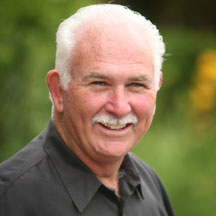Panasonic Phone Systems Orange County with Dennis Jenkins of DennisJenkinsco.com
Dennis: So, I’ve been running around at the last minute here, doing my little creative thing, because… the word came up this morning early on and said something like, “techno babble.” Well, it’s just like talking about T1’s and all this stuff. And there’s like two other people in the room that really understand what you’re talking about. The rest of you say, “Just make it work.” So you’re dealing with that, because you’ve got a solution that you’re trying to accomplish and you want it to be the most optimistic and friendly that it can be.
What I’ve done this morning is, I’ve created a situation in kind of a little fool around thing here, where I’ve got some examples of people that we’ve connected together and it makes it easy to communicate from one office to the other office. So, in one instance, I’ve got… Let’s see, what have we got here? Oh yeah, Barbecue Grill. Barbecue Grill, three locations, Santa Anna, Lake Forest and Vista. Okay.
Now, what I’ve done is I’ve given a piece of paper to Scott, one to Eric and one to Mary. Yes, it’s the one I gave you. Yeah, that’s the one. So, you can see that in that location you have a couple of different extension numbers. In order to communicate between these two locations or three locations, all one has to do is dial the digits. Scott, call Eric, who’s down in Lake Forest. You can dial him while I’m… 119. You can call Bob.
Call Bob, 119. Dial 119. That’s simple. It’s a bit easier than that. Okay? Call Mary and pretend she’s Jerry.
Scott: That’s 119 also.
Dennis: 119? It’s a miracle. It works everywhere. Then call him on 120, because 119’s busy with the other call. Somebody ought to audit this thing, just to get the number straightened out. What do you think? The idea is that now we have unification between three locations, just like a mail center does. Let’s see if he’s listening and that way it’s easy to communicate from one to the other. In this particular application, we’ve got another cool thing going on. The Santa Anna location has a 714 number. So, if they do advertising, the phones in 714, the Santa Anna location, begin to ring first, but if their staff is busy, the ringing picks up down in Lake Forest and Vista.
All of a sudden, they’re busy in the first store, the other stores… wait. Oh, you needed the other store? Oh yeah, I can see they’re on the line or they must be busy. How can I help you? Immediately you’ve captured that call because you have the ability to create this over flow condition. It’s still your company. It’s just a different branch. It’s still that person that you advertised for.
You got it. You’ve captured that customer. Lake Forest is 949 numbers and Vista has 760 numbers. No matter which one’s called, eventually they’re offered to all people, which means that all of them have the ability to help your customer. I have another scenario where I have a law firm. Let’s see who’s playing. Where did my numbers go? Oh, Shawn. I put something in front of you while you were busy.
Shawn: Yes. I can see it here.
Dennis: Oh, and it looks like… Okay. If you wanted to call Scott, who is pretending to be James in North Carolina, and you are in Santa Anna, what would you dial?
Shawn: If I wanted to call James?
Dennis: Yes. 42131. Notice it’s not three digits. The reason it’s not three digits is because that environment is two physical PBX’s. You don’t have just a couple of extension and a couple of extension or a couple of extension. You’ve got a facility that’s got 40 extensions in Santa Anna and another 50 extensions in North Carolina. It’s too big to put too many extensions over, so you tie the two systems together.
In this instance, four, two leading digit tells the system, go to the other location and it uses that internet connectivity that it has to be able to take that call from one to the other. You could transfer the call. You could just call somebody. You could just call James in North Carolina. That simple. Simple digit, the PBX, the internet, all of that takes care of all the work and makes it simple.
We’ve gone from techno babble to very, very simple dialing and that’s what communication is about. How about the economics of some of those kind of things? One thing that I’m working on right now is… [Man,] last night. I got a phone bill from a place called Enchanted Florist. Yes, I said Florist. Apparently there’s more than one of them around, but they gave me a phone bill.
On the phone bill, they’ve got ten phones in the place. They’re paying $367 a month for the phone bill. It’s about seven lines and I said, “Well, God, I want to buy some of these old phones.” I said, “Well, maybe it’s not the best thing to invest in some old phones. Maybe what we should do is, let’s look at some new technology. So, grab FIOS, 104 bucks. Put some [swim trunks] in there for 60 bucks. Put the fax server in there for ten bucks. Take all the rest of that away and your operating costs of that solution is $110 a month.
Well, 110 against 367, gosh, there’s a little bit of benefit there isn’t there? So, in order to do that we implement five grand in hardware. Oh, my God. Five grand in hardware? That’d take forever. Now, a little over two years and you’re done. Moving forward after that, you’re saving that $200 a month. Not a bad thing, so technology is helping us a lot on the financial side as well as the ability to communicate. When we make these calls, like we talked about in North Carolina and stuff like that, what does it cost Terry?
Terry: Nothing.
Dennis: It’s free. Oh, God. I was trying to queue him up for that. I thought it would be a lot of fun to have, “It’s free!” So, a little more interactive thing is going on because that… see? it worked. Okay. Questions? Yes, Jim. Yes, I can sign you up.
Jim: If you guys are having different locations, [inaudible 00:07:27] on call, basically?
Dennis: Yes.
Jim: What if you want to make phone number?
Dennis: You can do that. Phone number portability. You can always move your numbers. Sometimes I’ve had a dog fight or two with some providers. TelePacific, sometimes one of them was six months to get the numbers away from them, but eventually we got them and even if they’re safely at Cedar Sinai for some time now.
In your situation, I was thinking about you. In your situation, you could be really clever. Get one account. You’re a simple situation. One account, two phones at one location, extension 1001, 1002. The other location 1003, 1004. Same game with the phone number. Phone number for your store rings on the first two phones first, but carries over to the second store if you don’t answer and vice versa.
Jim: And when you got a third store?
Dennis: Third store? Not a problem.
Jim: So, how to cause problems?
Dennis: Well, how many do you want? I mean, it’s pretty simple. At some point in time, you go to this environment where you put the PBX in place because you’ve got too many calls going over your trunks, over your [swim trunks], or over your internet, and you’re going to get saturated with that unless you’ve got a huge trunk. Or, if it’s a huge like the Time Warner I got a call on last night, 35 by five, we can’t make four phone calls. Call quality is bad and there’s something wrong with that pipe, but you understand what I’m talking about. Yeah, you got it.
Jim: What’s a zip line?
Dennis: Zip? Sip not zip? Not this. Not that thing you hang onto for dear life and you slide down the rope. Sip line, session, initiate and protocol. You asked for the techno babble now, didn’t you? You had to ask me that, didn’t you? It’s a voice line going across the internet. When you talk you don’t have a physical hard wire from the phone company. It doesn’t go out over GTE, Verizon, AT&T, whatever. Okay? It goes out over the internet and then out to its destination. So, it’s packets. It’s packets, where’s my packet?
Jim: It’s packets.
Dennis: Yes, Jim.
Jim: If… beyond the installation, are you the service or is the manufacturer the service?
Dennis: The provider?
Jim: No, the ongoing…
Dennis: The ongoing service?
Jim: …service fixing…
Dennis: I’m interactive with that, okay. I’m interactive with that. I get a call last night and the guy says, I’m having problems with this. Is it the provider, is it the pipe? Well, how do we prove it? That kind of thing. I’m always interactive in that. I don’t go away from that.
Jim: Very good.
Dennis: I’m good? All right, thank you.
Dennis Jenkins 11943 Agnes St. Cerritos CA, 90703 (562)402-0100 denjenkins@earthlink.net www.dennisjenkinsco.com

